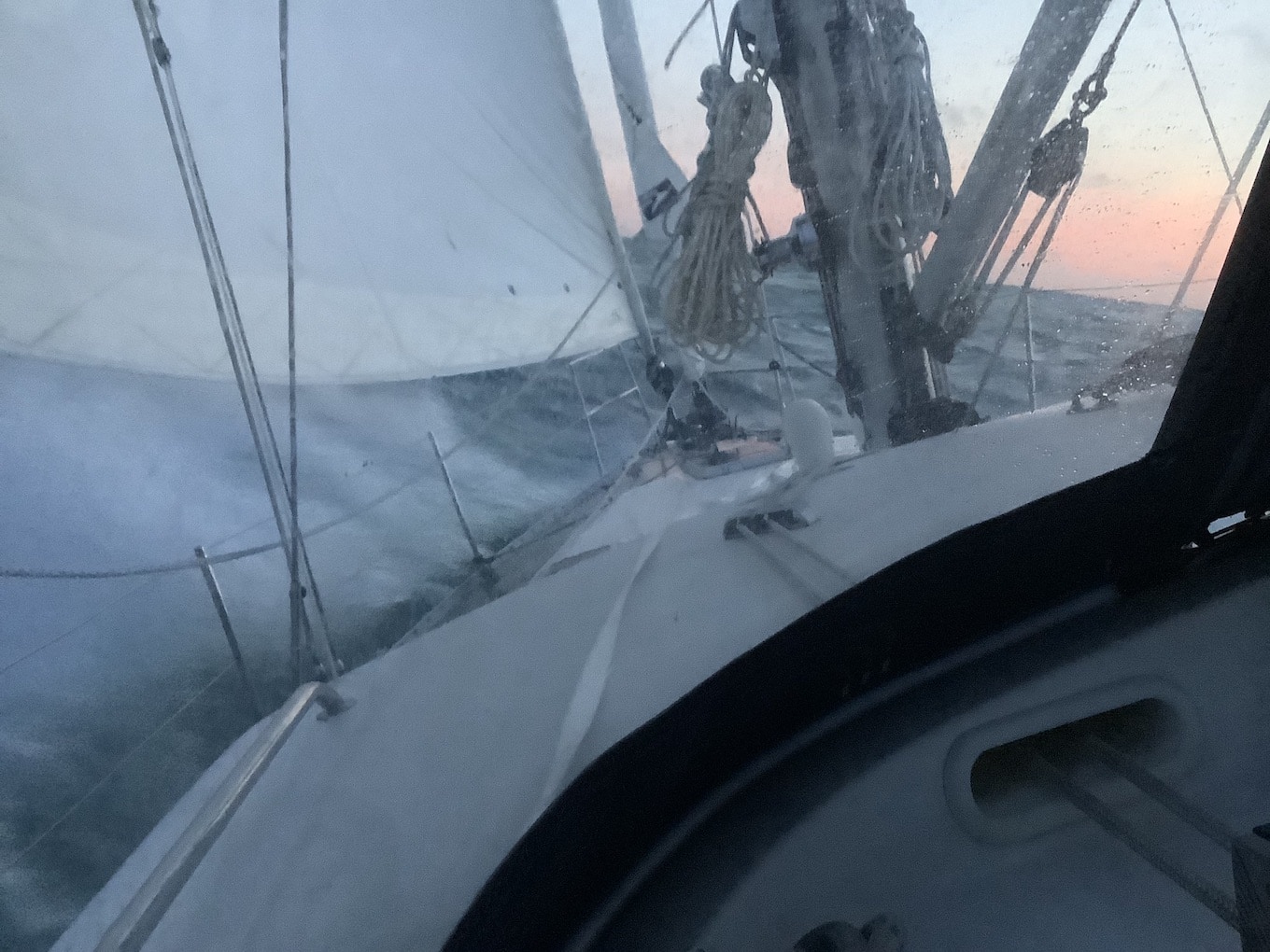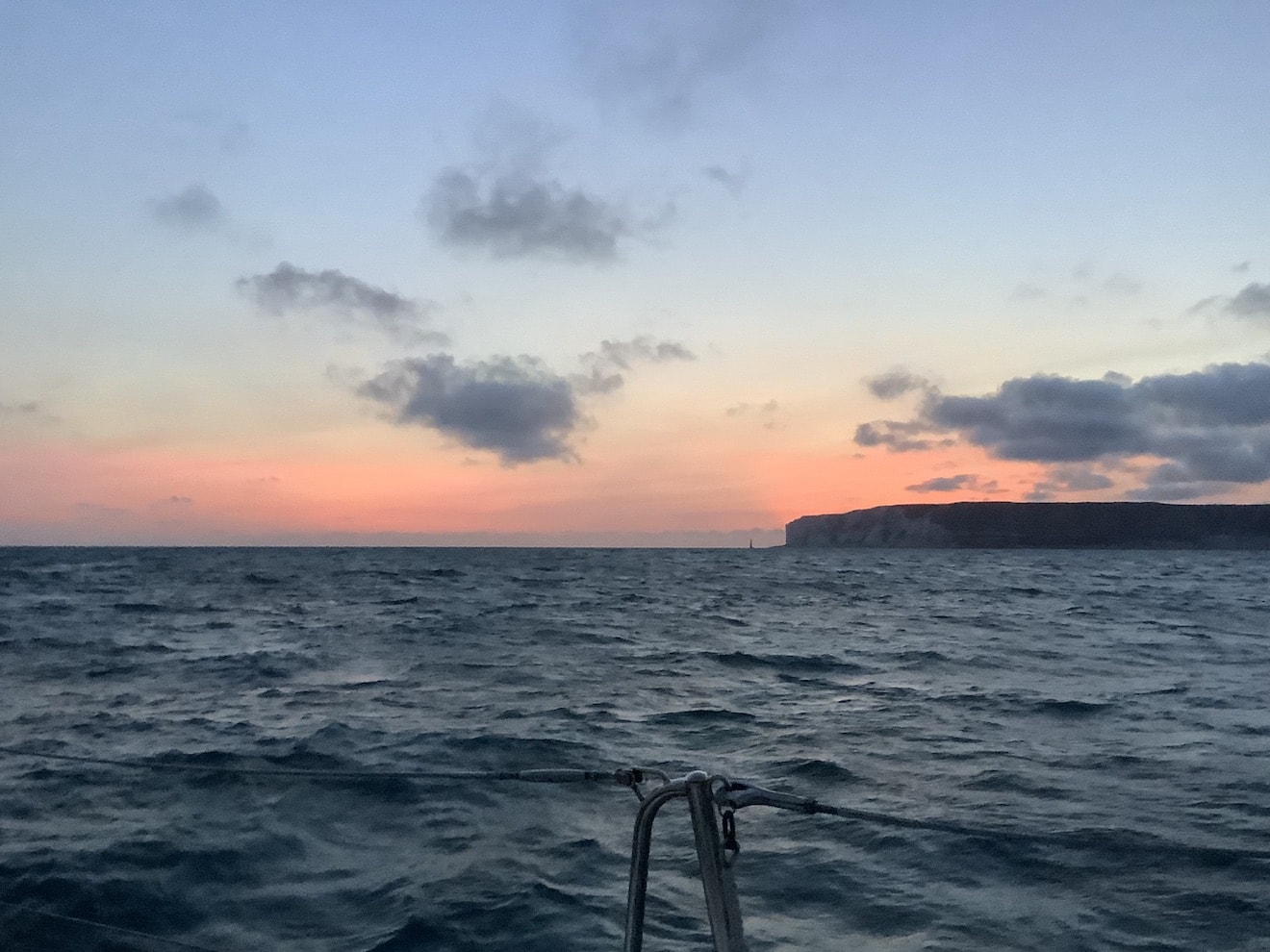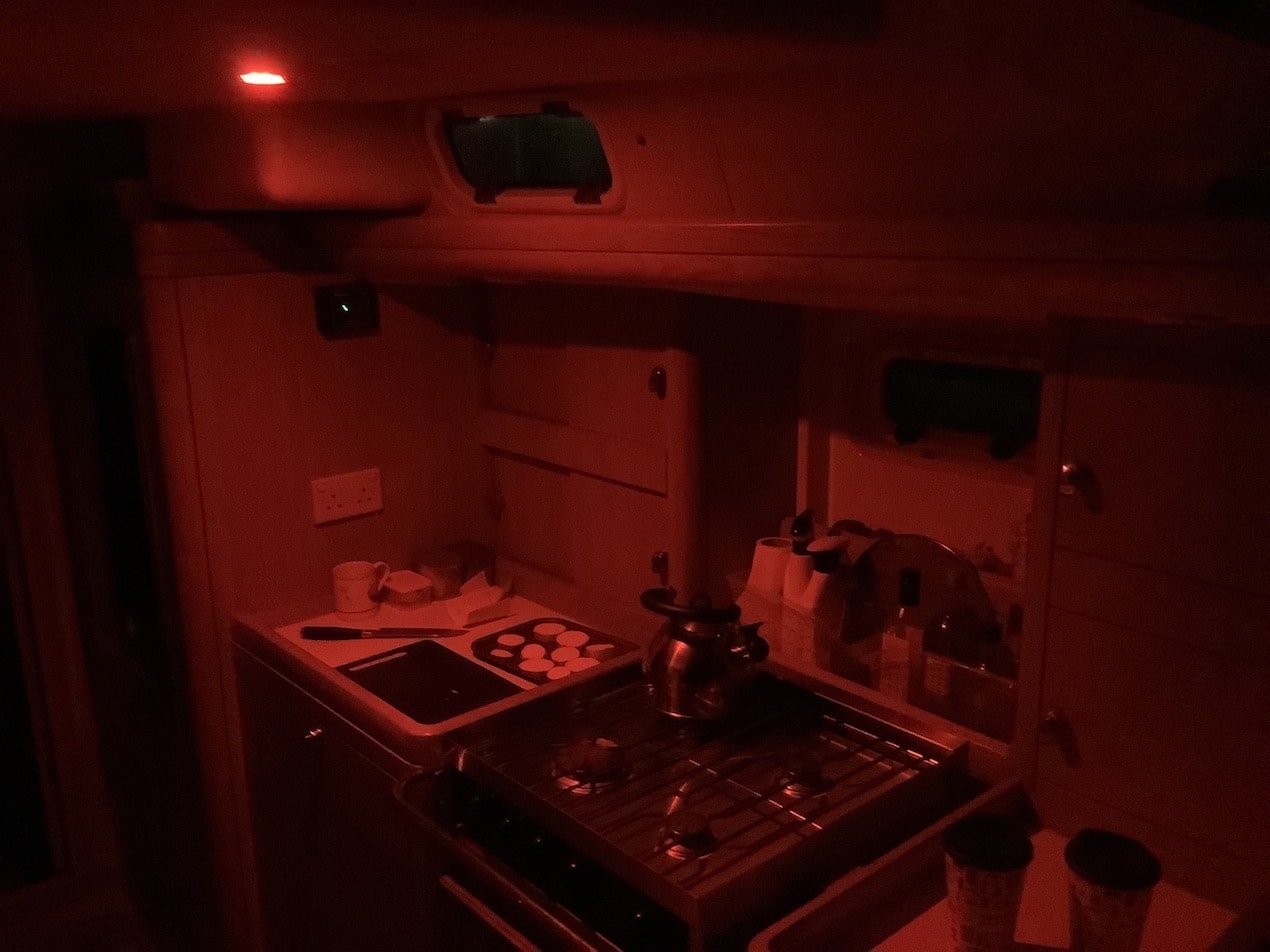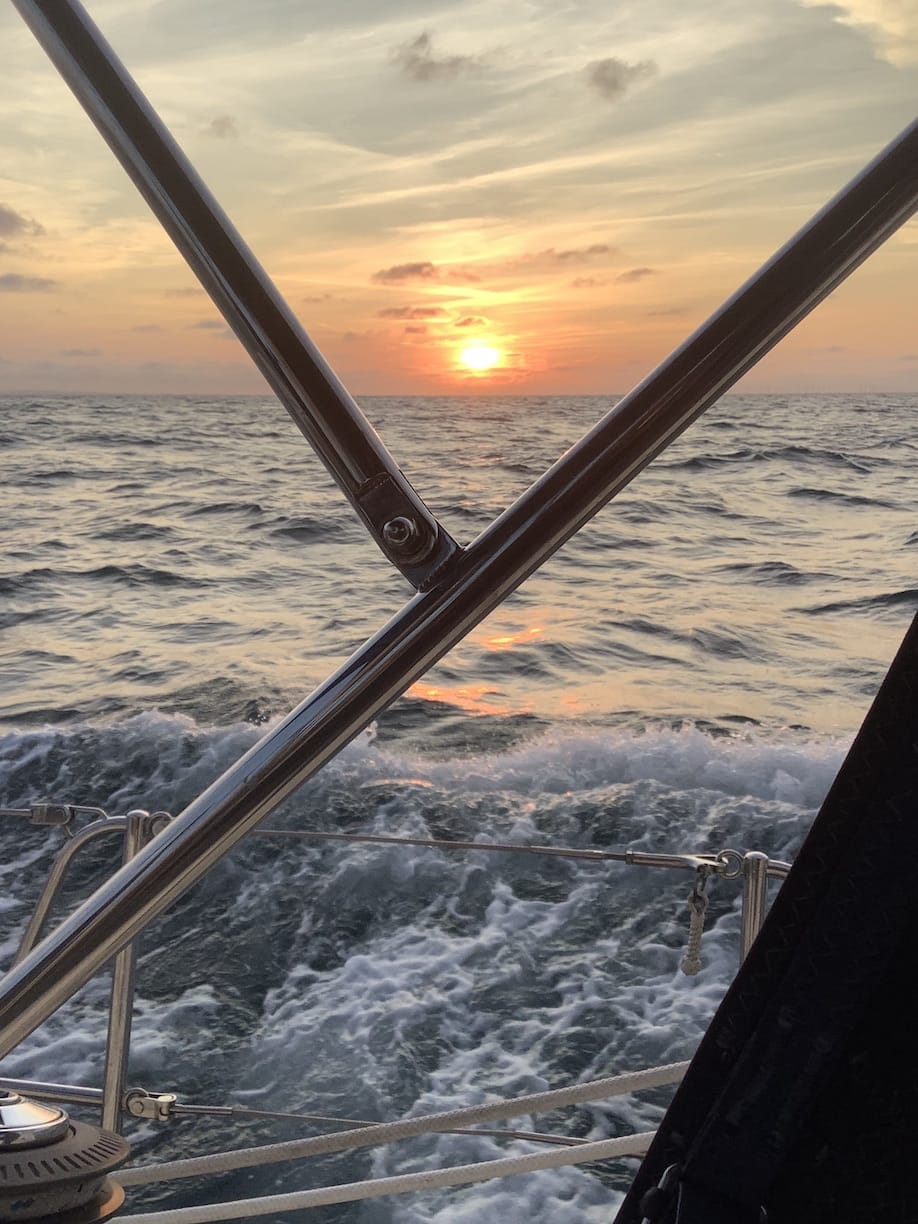The next leg of our journey was to take us from Eastbourne to Gosport (in the Solent). The Almanac told us that this would be about 60 miles, so we were expecting it to take us about 12 hours, depending on winds.
As this adventure was about building up experiences, we decided that we would make this journey our first overnight passage. A scary prospect!
After checking the weather and tidal flows (especially around the headlands of Beachy Head and Selsey Bill), we decided to set off at 6.30pm. This meant that, if all went well, we would be entering the Solent at first light. However, if the journey took longer than expected, we would still have the daytime hours as a safety net. This turned out to be a prudent plan!
As we left the lock at Sovereign Harbour Marina and motored past the navigation buoys out to deeper water, the sun was dropping lower in the sky. The wind was blowing Force 4 (11-16 knots) gusting Force 5 (17-21 knots) which would have made great sailing. Unfortunately, it was from the SW, exactly the way that we wanted to go. It is not possible to sail directly into wind (30 degrees is the closest) so we had to decide – motor in a straight line or sail with the wind. Sailing would mean a longer journey as we would need to to tack in order to get the wind angle right. However, as we were not sailing in a small space like a lake or river, our course changes would be way apart…generally 10 to 15 miles (two to three hours). We decided to sail.
We knew that it may be gusty in the night and didn’t want to over power the boat, especially for our first night sail. So, we chose to sail with the Genoa and the mainsail reefed (ie not furled out completely).


We made good time and soon we were sailing past Beachy Head and out to sea, towards the TSS (traffic separation scheme). These are areas with designated directional shipping lanes; like a road for big vessels. We wouldn’t be sailing in these, but running parallel to them down the Channel.
As darkness fell, it was interesting to see the different lights around us: towns on the coast and vessels at sea. It was good practise identifying them – other yachts sailing, large cargo ships or passenger ferries motoring and fishing vessels casting their nets. All presented possible hazards for us to be aware of.
The next challenge was to prepare something to eat. I had suggested preparing something before we left and then just heating it up, but Martin was keen to cook on the move. The boat was well healed over and he was using our inside red lights to preserve night vision. Good job it was him…I think I would haver been sick!
Martin (of course) did an excellent job: Prawn stir fry with noodles… yummy.

When we go on longer journeys (up to four weeks), we will need to organise a shift pattern to ensure that we both get some rest. There is much debate about the best pattern to use for two people: fixed hours on/off, either 2, 3, 4 or more flexible. This is something that we will need to try out to discover what works for us.
As this was a short trip, we decided to be flexible and sleep when we were tired. I was a little nervous about the night passage, especially as it was quite windy and a little choppy. This was not conducive to sleep, so, much to Martin’s surprise, I did not fall asleep at my usual 10pm time. This meant that I was left in charge while he went for a sleep…a brave man.
I am not that keen on the dark, so initially I was quite skittish, feeling each lump in the sea and gust in the wind. After a while though, the boat’s movement became a more established pattern and I was able to relax more.
We have an autopilot on Escapade, so I was able to set a course for her to follow. My tasks were to continue to keep look out for other vessels, monitor the wind strength and direction and adjust our course and sails to account for these things. It kept me busy!
As sailing Escapade is still quite new to us, we had agreed that we would both be on deck for major changes to the direction and sails. It is much easier with two of us. So when the time came to tack, I woke Martin up.
Still not ready to sleep, I carried on watch while Martin got a couple more hours sleep, but, by the next tack at 3am, I was needing my bed.

It was a strange experience, going to bed on a sailing boat. As the boat was healed over, the safest way to lay down was across the bed. Laying in the recovery position helped too, as it stopped me rolling. The boat was also riding up and over the swell, so it felt like we were going over humped back bridges. I didn’t think I would ever get to sleep.
However, nearly three hours later, Martin woke me to tack again. I was surprised to see that the sun was rising…we had made it through our first night sail!
The journey wasn’t over yet; we still had about 40 miles to go. We continued to sail towards the Solent watching the sky lighten and we eventually arrived at Royal Clarence Marina at 2pm – over nineteen hours and 100 miles after leaving Eastbourne. A long but successful passage.
WOW how exciting hun. You both did very well. A big step for you staying awake at night and captaining g the boat. Where are you off to next?
Hi,
The whole trip has been a huge learning curve and at times pushed me well out of my comfort zone!!
From the Solent we went to Poole and Portland. Then 5 nights in Dartmouth, followed by 5 in Salcombe – hiding from the winds. Tomorrow we start our journey back towards Ipswich.
X
So the Autopilot is not George when Caren’s sailing he suddenly changes sex?
Next report should be interesting 😃
Hi,
Meant her as in the boat…..
C x
You are in Solcombe Devon
According to my spy 🧐 beautiful village.
Many happy times there wonderful walks and beaches
Enjoy 😊
We are, your spy is correct!
We have been here for five nights and it is lovely. Even managed a couple of walks between the showers.
Leaving tomorrow, heading for Portland
xx
Well done guys. Sounds like a very sensible and relaxing first trip away. Thoroughly recommend a book called Sopranino by Patrick Ellam and Colin Mudie. Still available on Amazon. It tells the story of 2 guys who decided that they could build and sail a 20ft boat to America, 2 handed. Some great anecdotes in there, (e.g. meeting Hemmingway) as well as masses of practical stuff on what works in a 2-handed watch system.
Hi Will,
We are definitely learning lots!
We will check out the book; any advice from other sailors is always welcome.
Hope you journey back home is going well – we are following your progress on your website!
Safe sailing
Caron